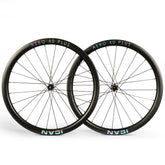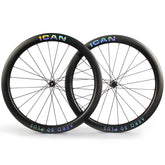How to choose the right handlebars
When looking for a new frame or purchasing new bike components, one of the most frequently asked questions is about handlebars. This is very logical as this is one of the main points of contact with your bike. But there are several features you need to consider when looking for the perfect handlebar setup. Here you will find some tips.
How to choose the right handlebars
When choosing a new handlebar, one of the most difficult decisions is the choice of material used. There are two options available to you: a handlebar made of carbon or aluminum. Both materials have their unique advantages and disadvantages.
Carbon material is known for its comfort as it is usually better at absorbing vibrations from road bumps. Aluminum passes more of these vibrations through your hands. Carbon handlebars are also known for their stiffness. Many people think that aluminum handlebars are stiffer than a carbon handlebar because they feel rougher, but this is due to the aforementioned difference in vibration dampening between the two materials. Another advantage of carbon handlebars is the weight, as a rule a carbon handlebar weighs less than its aluminum counterpart.
Of course, all of these benefits come with a certain price. Because carbon handlebars are a higher quality product, they tend to be more expensive than a regular aluminum handlebar.
What about the durability of a handlebar made of two materials?
In terms of durability, both materials are on par. Both can endure the rigors of driving without breaking. However, on an aluminum pole you will notice the impact and stress it has endured as it tends to bend, dent or deform. With a carbon handlebar, however, these symptoms of fatigue do not occur. When a carbon handlebar reaches the end of its life cycle, it simply breaks.
How to choose racing wheels correctly
On a road bike, it is very difficult to choose the right road handlebar due to the multitude of options available. We will give you some tips on how to choose the right handlebars.
Choose a suitable width
The first point is the handlebar width. As you all know, we are not all shaped the same. For this reason, drop bars are available in sizes from 38 cm to 46 cm.
Generally, the size of the drop bar is selected based on your height, although it has nothing to do with it. Your shoulder width is crucial. It's best to choose a handlebar that's the same width as the distance between your AC joints at your shoulder. However, remember that wider handlebars will reduce aerodynamics and make your ride more stable. Depending on your priorities, you can always increase or decrease the size.
Handlebar reach
Next comes the handlebar reach, i.e. the point where the handlebars reach furthest forward. The brakes are usually mounted there. This indicates how far forward you will stretch. Again, this is proportional to your height. A shorter rider has a shorter range than a taller rider.
Falling
The last measurement point concerns the drop. This is the distance between the top of your racing wheel and the bottom part. Again, the drop is selected based on height; a taller rider will generally have a bigger drop than a shorter rider.
A shorter drop means that the transition between the brake levers and the drops is much easier and requires significantly less stretching of the muscles. Therefore, flexibility also has a big influence on the choice of your drops. This is certainly something to consider if you're having trouble getting into the drops.
To put all this into context:
-
Compact Drop - 120mm Drop
-
Medium Drop – 135mm drop
-
Long Drop – 150mm drop
Aero handlebars
For some of us who like time trials, triathlons, ultra-long distance events or have the goal of achieving the Strava KOM, simple drop bars are not enough to achieve the extra speed. On a drop bar your arms are further apart, while on an aero bar they are folded, creating a more compact positioning for a more aerodynamic stance with less drag.
When looking for aero bars, there are two options: full aero bars and clip-on aero bars.
What are the full aero bars?Full aero bars are what you see on most time trial bikes. They have special shifters and brake levers so you don't have to change your body position when using the aero bars.
Note that if you want to convert your regular road bike to full aero bars, it will be a significant investment as you will not only need the aero bars but also new shifters, brake levers and all the hassle of wiring your cockpit. A full aero bar also has fewer adjustment points than a clip-on one.
What are the clip-on aero bars?
Clip-on aero bars are ideal for the occasional time trial and triathlon rider. They offer almost the same benefit as full aero bars, but at a fraction of the cost. You can install them whenever you want, and when you no longer need them, you can remove them. You can also keep your traditional racing handlebars.
The clip-on handlebars attach to the central section of your handlebars and change your riding position up or down.
What are the clip-on aero bars?
Clip-on aero bars are ideal for the occasional time trial and triathlon rider. They offer almost the same benefit as full aero bars, but at a fraction of the cost. You can install them whenever you want, and when you no longer need them, you can remove them. You can also keep your traditional racing handlebars.
The clip-on handlebars attach to the central section of your handlebars and change your riding position up or down.
The last thing you need to think about is your comfort on the aero bars. This means that you need to check for yourself the shape of the extensions themselves, the adjustability of the handlebars and pads, and the correct adjustment of all components. The best way to check this is to film yourself on an indoor exercise machine and check your position and frontal area. Here you'll see how changes to your setup can make you look more aerodynamic or more comfortable on the aero bars.
When investing in a new mountain bike handlebar, there are a few things you should consider before purchasing. The specific geometry of an MTB handlebar consists of three parts:
- Width
- increase
- bend
Width is simply the measurement from end to end of the handlebar, and typically MTB handlebars vary from 720mm all the way up to even 840mm depending on the riding discipline.
For example, a downhill rider will always have wider handlebars simply because they are more stable and comfortable at high speeds. While cross-country riders tend to prefer narrower handlebars as they are more agile and aerodynamic. The choice of handlebar width, as with road bike handlebars, is based on your shoulder width, but as a general rule certain handlebar widths can be assigned to specific MTB disciplines:
- 720 – 740 = Cross Country
- 740 – 780 = Trail/Enduro
- 780 – 840 = downhill
The increase essentially refers to the height difference between the middle of the handlebars and the ends of the handlebars. MTB handlebars have increases from zero to even 100 mm. Again, the choice of handlebar riser depends on what you plan to ride. A cross-country racer will likely prefer flat handlebars or just a minimal rise as this will support their body position on all climbs, while a trail or enduro rider will prefer more raised handlebars as their body weight is distributed differently. Higher handlebars keep the body more upright, which is necessary when riding on steeper terrain.
Sometimes a different handlebar elevation is chosen for medical reasons. Some riders choose higher handlebars to take the strain off their backs.
Bend refers to the angle the handlebars have back to the bike. This has a big impact on your posture while driving. The greater the inward bend, the more your elbows will drop, allowing for a more relaxed position. While a handlebar with less flex allows you to have a more aggressive riding position with your elbows out, which is required in certain riding conditions.
In summary
Now you know what factors we should consider when choosing bicycle handlebars. Every situation is different, so there is no clear answer as to which bars are best.
Choosing your new handlebars must be based on the type of cycling you do, your physique and what you find best for your riding style. You can also watch the video below.






